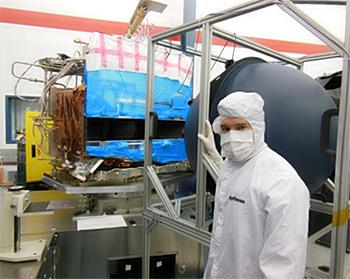
While this makes sense in some cases, delivering cooling from the ceiling has several advantages. Since radiant heating systems tend to be in the floor, the obvious choice would be to use the same piping for circulating cooled water. Radiant cooling from a slab can be delivered to a space from the floor or ceiling.

Typical radiant cooling installation methods. Radiant cooling panels are designed so that they can be retrofitted into the ceilings of older buildings as the plenum space requirement is minimal relative to fan coil units or VAV systems. The lower thermal mass of panels allows them to react very rapidly to changing loads.

Panels offer installation flexibility in terms of where they can be placed and how they are integrated with dropped ceilings, lights and other electrical systems. Radiant cooling can also be delivered through specialized panels, which would typically be attached to ceilings, but can also be attached to walls. Radiant cooling slabs require a close tube spacing of six to nine inches on centre, which is a little tighter than the nine to 12-in. Chilled water between 55F to 58F is circulated through the pipes, which are embedded in either floor or ceiling. Radiant cooling slabs use similar design and sizing principles as a hydronic radiant floor system, using the same types of PEX pipes, manifolds and pumps as in heating. Radiant slabs can be arranged so that they are exposed on both sides, providing, at different times of the year, radiant heat to the space above and radiant cooling to the space below. Often referred to as thermally activated building systems (TABS), this large thermal mass can be advantageous for some applications, where the mass can be “charged up” during times of off-peak electrical rates. Chilled slabs offer benefits of integration into the building, lower installed cost and increased thermal mass. There are two broad types of radiant cooling systems, which are chilled slabs and radiant panels. It is possible to have radiant panels that provide both heating and cooling, providing the best comfort and efficiency all year long. Energy radiates from the objects, people, equipment and lights to the cool surface, which is opposite to what happens in heating mode, where the heated panel radiates to the objects and people. Thermal energy is exchanged by radiant heat transfer between the heat loads present in the space and the cool floor or ceiling. Radiant cooling follows the same principles as radiant heating, but in reverse. Residential applications are not very common, but can be installed if they are very carefully controlled,” adds Leyte. “Most applications for radiant cooling are in commercial applications such as airports, offices, schools, and large public areas such as museums.


“There are radiant cooling systems installed in the Calgary and Winnipeg Airports, as well as the Toronto District School Board and Manitoba Hydro Place office that are performing exceptionally well,” notes Leyte. According to Jerry Leyte, Central Canada sales manager for Uponor, there are now quite a few radiant cooling systems installed in Canada. Radiant cooling systems have been widely used in Europe for some time and they are starting to become more popular in North America, especially in the dry climates of Southwest USA. Ask many of those same engineers and contractors about radiant cooling systems and you will probably get a mix of confusion, fear of the unknown and dismissal.Ĭooling with radiant however, offers many of the same benefits as radiant heating cooling systems that are comfortable, efficient and quiet. These systems have become an accepted part of the HVAC offering of many engineers and contractors, as they have proven to offer customers comfortable, efficient, healthy and quiet heating systems. Most heating professions are very familiar with the principals of radiant floor heating systems and how they work. Manitoba Hydro Place in Winnipeg, MB, is a well-known application of radiant cooling.


 0 kommentar(er)
0 kommentar(er)
